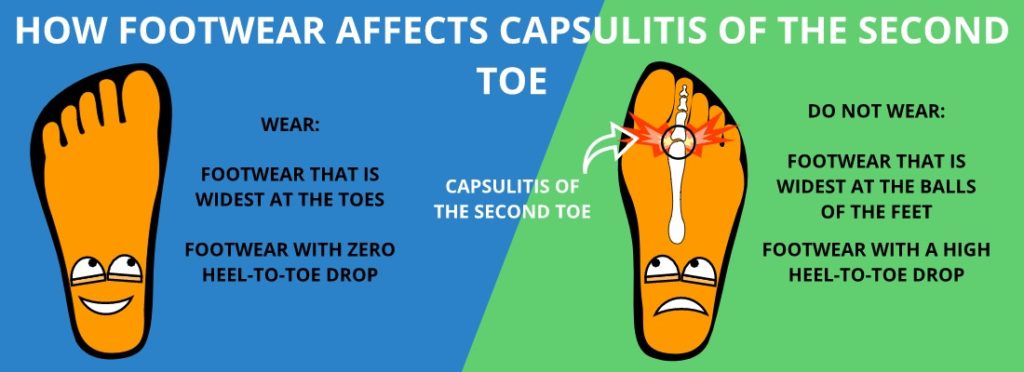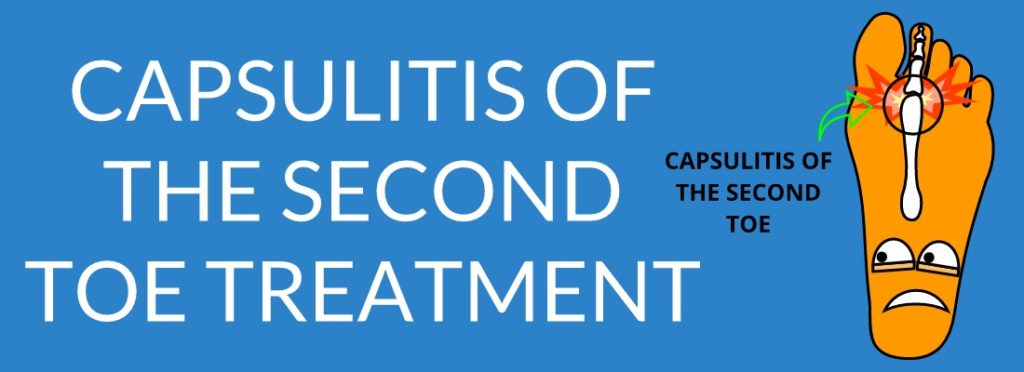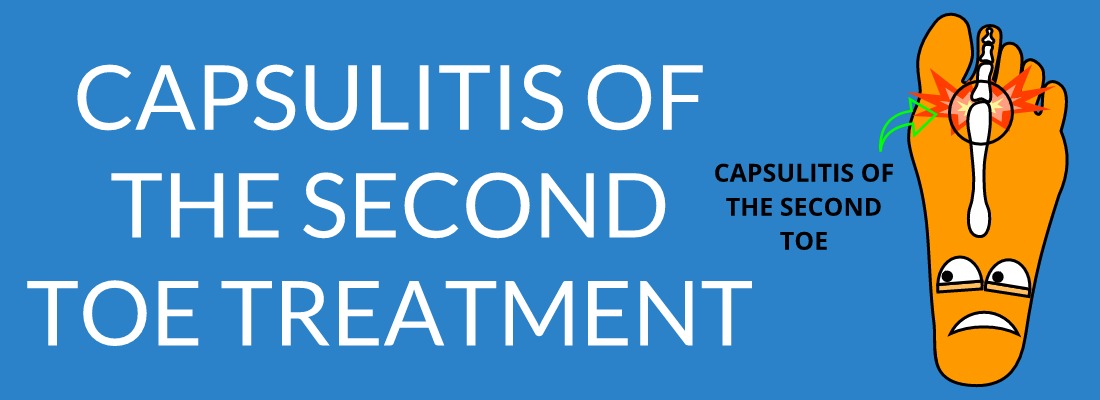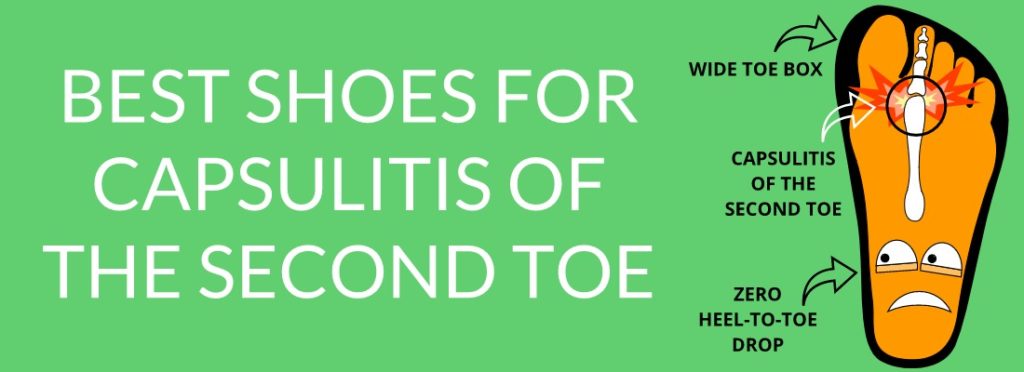What Is Capsulitis of the Second Toe?
Capsulitis of the second toe is a condition wherein the ligaments surrounding the second toe become inflamed. It is a common condition that is found to occur equally in men and women of all ages.
If left untreated capsulitis in the foot can cause immense pain and discomfort. Weakened ligaments can lead to the formation of a hammer toe or the dislocation of the second toe.
For this reason capsulitis is also known as pre-dislocation syndrome.
It is important to note that capsulitis can also occur in the third and forth toes, although it is far more common in the second toe.
The proper functioning of the second toe is dependent on the ligaments that surround it forming a capsule. In this article we’re going to discuss how these ligaments break down and what you can do to recover quickly.
Causes Of Capsulitis of the Second Toe
Capsulitis of the second toe is caused solely due to improper or abnormal foot mechanics. This can be due to several factors that usually include overpronation of the feet due to the following factors:
- Flat Feet
- Excessive bunion deformity
- A Forefoot Valgus
- Second toe being larger that the first/big toe
- Tight Calf Muscles

Capsulitis is also caused by the contraptions we call shoes.
You see, the toes were meant to splay out and stay in the same plane as the heel, when in contact with the ground.
Modern footwear crams the toes together, while raising the heel in the shoe. High heels in shoes are a major contribution to this condition.
This causes excessive loading on the ball of the foot, which then causes swelling and discomfort in the area.
Adding a toe spring at the front of the shoe is a further disservice as this elevates the toes. Thus causing the natural fatty padding under the ball of the foot to be spread thin.
Hence shoes as well as the aforementioned conditions cause the joint of the second toe to bear excessive loads. Thus, inflaming the tendons surrounding it and causing injury.
Symptoms Of Capsulitis of the Second Toe
The symptoms of capsulitis of the second toe are all localized around the second toe, in the ball of the foot. They include:
- Pain in the ball of the foot directly under the second toe joint
- The pain tends to feel like there is a stone stuck under your foot, or like socks being bunched up
- Wearing shoes poses difficulty, especially wearing shoes with high heels or high heels themselves
- Swelling around the second toe
- Redness/Tenderness of skin overlying the affected area
- Difficulty walking on hard surfaces or barefoot
- Formation of a painful callus right under the second toe or surrounding area
- Final stages include the weakening of the tendons around the affected joint. This causes the toe to lift up and drift to either side or to cross over the big toe. The occurrence of the former is known as hammer toe, while the latter is known as cross over toe. Complete dislocation of the second toe is also possible.
Self Diagnosis Of Capsulitis Of The Second Toe
The symptoms of capsulitis can be easily confused for another condition known as Morton’s neuroma. Morton’s neuroma is treated differently and hence it is extremely important to diagnose capsulitis correctly.
The tendency for the surrounding structures of the foot to become inflamed make it even trickier to diagnose capsulitis properly.
It is important to note that capsulitis of the foot is a progressive disorder that is bound to worsen if left untreated.
Although, the condition responds well to basic non-surgical treatment, early diagnosis will put you on the path to a speedy recovery.
The easiest way to visually diagnose capsulitis of the second toe is:
- Check for swelling around the affected area. Sometimes swelling can be on the top of the foot, but usually it is noticed at the bottom of the foot.
- If swelling is not present, hold and the move the second toe in an up and down motion. This should trigger a pain response.
- Hold and push the toe upward, trying to feel for where the metatarsal joint is located. Apply pressure with the finger about a thumb’s distance above the location of the joint. This should recreate some of the pain felt while walking or standing.
Capsulitis of the foot can often be misdiagnosed for a plantar tear. Therefore, it is always best to take an X-Ray of the affected area.
Capsulitis Of The Second Toe Treatment
Capsulitis of the second toe responds well to conventional treatment if a regimented treatment plan is followed.
Proper treatment of this condition involves aggressive inflammation control through the use of shoes, orthotics and taping of the second toe.
I cannot stress the importance of using a holistic approach when trying to treat capsulitis of the second toe at home.

The following treatments will ensure a speedy recovery.
- Rest and Relaxation: As with any injury to the foot, resting the affected area will pay back dividends tenfold. This is more true for capsulitis of the second toe. Rest is a commonly underestimated and overlooked aspect of treatment and negligence to do so can have dire consequences for the toe. Our feet get abused day in and day out. And they are fully capable of taking a thorough beating. But, when they get overused or injured, it is of utmost importance to give them a much required time out. doing this will help reduce irritation and inflammation in the affected area. Try to stay off the affected foot as much as possible. Remember, capsulitis is known as pre-dislocation syndrome for a reason.
- Icing and Elevating: Along with resting the affected foot, icing the area will help control the swelling. Placing an ice pack on the affected area for fifteen minutes 3 times a day will help keep the inflammation in check. You can place the foot in an elevated position for 10 to 15 minutes at a time while lying down. This will also help reduce any swelling in the area. You can easily do this while lying down by placing cushions or pillows under your feet.
- Stretching the Calf Muscle: Whether you suffer from tight calf muscles or not, stretching them will help. I do not recommend standing on your feet in order to stretch the calf muscle. Instead, you can purchase a TheraBand from Amazon, and use it to stretch your calf muscles whilst being seated. This will ensure that no load is placed on the affected foot. It is absolutely important to make sure that you do not stretch your toes when attempting to stretch your calf muscle. When using the TheraBand to stretch your calf muscle, place the band under the arch of your foot, never under your toes. Failing to do so can aggravate the condition, which is not the point of this exercise.
- Offloading the second toe: Orthotics are cheap and extremely effective in redistributing the load away from your second toe. This will help you get back on your feet faster.
- Change in footwear: As stated above, wearing the wrong footwear is most likely what got you here in the first place. Tight toe boxes, raised heels and toe springs are a strict no no. Instead opt for shoes that don’t constrict your toes and are flat. If you are flat footed or suffer from forefoot valgus, using an orthotic will help reduce the risk of re-injury. You can wear shoes that are overly cushioned, but don’t wear shoes that have none. You can check out the Best Shoes I recommend For Capsulitis of the second toe here. Of course, it is needles to say, stay away from high heels.
- Taping the toe: A simple kinesio tape will get the job done here. Taping the second toe for capsulitis will help keep it in a neutral position. This will reduce the risk of re-injuring the toe during the rest phase. I have made a video detailing two methods for capsulitis of the second toe taping.
- Using Anti- Inflammatory Agents: Non steroidal anti-inflammatory medication or supplements may be prescribed by your doctor to help combat the swelling.
As mentioned above, early diagnosis and treatment of capsulitis will improve the integrity and stability of the joint. It will also reduce pain and swelling in the area.
This is why if you are feeling any pain at the ball of the foot around the second toe, immediately deload the foot. Provide ample rest (generally between 3 to 6 weeks) and diligently perform all anti-inflammatory treatments mentioned above.
Surgery For Capsulitis Of The Second Toe
If the aforementioned treatments fail to work and the ligaments progressively become weaker, then surgery might be advised.
Surgery involves re-positioning or shortening of the bones.
This is usually advised when the second toe starts to move toward the big toe. As once this happens, the condition becomes irreversible.
Surgery is not without risk, as re-positioning or shortening of the bones might then transfer the load onto the other bones, thus transferring pain along with it.
Conclusion
Capsulitis of the second toe can cause a lot of complications, pain and discomfort.
While the condition responds well to conventional methods of treatment, such as rest and anti inflammatory treatment, early diagnosis of the problem is of absolute importance.
Sources:
https://www.acfas.org/Content.aspx?id=1482
https://www.nwfootankle.com/foot-health/drill/3-problems/23-capsulitis
https://www.ncbi.nlm.nih.gov/pmc/articles/PMC5367573/



can you show me a picture?
Hi, great article! Where can I find the video to learn how to tape for capsulitis?
Perhaps mention shoes that are zero drop and with wide toe box to help comfort?
Do you have instructions taping the toe?
“You can check out the Best Shoes I recommend For Capsulitis of the second toe here. “
The link is no longer live. It is very hard to find women’s walkers that fit me and can take a stretch in the toe box. I have 9 1/2 AA feet with a AAA heel, wide toe box. Brooks Addiction is now made with materials that won’t keep a new shape after taken off the stretcher. Orthoheel accommodates my orthotic as well, but still pushes my toes together. I need the support of a walking shoe with my orthotic for my Achilles issues. Ideas?